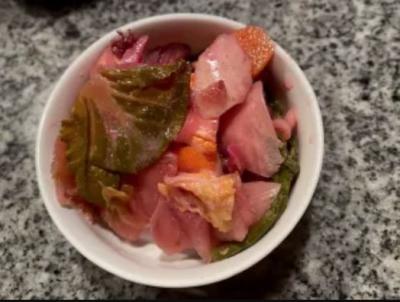
The History
Fermenting food is not a human invention; rather, it was a natural phenomenon that humans observed and learned how to cultivate. Two billion years ago, bacteria were the only inhabitants of the Earth, supporting the process of anaerobic (without oxygen) fermentation and transforming our planet. Bacteria still play an important part in our lives and give us amazing and healthy foods because fermentation overall improves the bioavailability of nutrients and supports digestive health.
I Have Salted Vegetables; I Can Survive the Winter
The main nutrient in ferment is vitamin C. Chinese philosopher Confucius wrote in the 6th century BCE: “I have salted vegetables; I can survive winter .”Fermented alcohol residue was discovered in 9000-year-old pottery shards. British sailor Captain James Cook is credited with conquering scurvy (vitamin C deficiency) during his long ocean voyages by bringing barrels of sauerkraut with him.
Humans spent 10 000 years figuring out how to best feed themselves, and fermenting foods is a great legacy they left us. Fermented vegetables have been a critically important food for survival in colder regions. The process developed as a survival strategy for people living in regions where fresh vegetables were unavailable during the winter months. Fermented food becomes stable without refrigeration and keeps well in the back of the refrigerator. Fermented vegetables have a distinctive, tangy flavor and can be used as a condiment to enhance other dishes.
Fermentation is Known in Every Culture
Fermented foods are an especial part of diets in all parts of the world. It is said that fermenting vegetables originated in China. Kimchi is Korean in origin, and Sauerkraut is German. Sauerkraut is made from cabbage, but kimchi can be made from any vegetable, even watermelon skin or flower blossoms. Regional and family recipes are often passed down from generation to generation. Europe also has a long tradition of fermentation. For example, the process of preserving olives (which, eaten raw, are bitter and toxic) has changed little over the centuries. Bacteria have been used to transform milk into yogurt and fruits into alcohol for centuries.
In the Middle East, fermented grape leaves are stuffed with spiced rice and made into dolmas. Russians have been making sour pickles, also called the kosher dill pickles, and a popular fermented drink called kvas for generations. A famous ferment for the Hawaiians is poi, a paste made from a potato-like root, taro. Sourdough bread, salami, pastramis, and prosciutto are all based on the fermentation process, and so are some cheeses, tempeh, chocolate, vanilla, vinegar, coffee, and certain styles of tea. Miso, synonymous with Japanese culture, is becoming popular in western cultures because research suggests that it may effectively remove heavy metals from our bodies.
Unlike the German word sauerkraut, the English language does not have its own word for fermented vegetables. Fermented vegetables are not pickles since pickling is just a style of preservation in acidity, and most pickles are not fermented. To learn more about pickling and cucumbers, read here, here, and here.
The most popular vegetables to ferment for long storage are cold-weather vegetables harvested late in the season as temperatures are cooling, such as cabbages or radishes, carrots, turnips, parsnips, celery, and parsley root. Bitter vegetables will mellow through fermentation. Vegetable fermentation is very versatile; there are limits, but some are more suited to fermentation than others. Live probiotic cultures cannot survive above 115F, meaning that fermented foods like miso, kimchi, and sauerkraut should be added at the end of cooking to preserve their gut health benefits. Fermentation bacteria also flourish in the dark, while light kills them. Keep the fermentation vessel in the dark or lightly dim places for the best results.
Canningwas invented in France in the early 19th century, and together with freezing and chemical preservatives, it largely replaced fermentation. Fermenting food has been experiencing a comeback as people learn about and begin to appreciate the health benefits of live-cultured food. Modern science is taking fermentation even further; cultured bacteria can decompose old rubber tires, clean up oil spills, decompose plastics, and chemical warfare.
Kimchi
Kimchi goes with about anything; scrambled eggs, soup, cheese sandwiched, and fried rice dishes. Certain foods are an acquired taste, and fermented fish sauce containing kimchi is definitely one of them. A milder version can be made for those just starting with fermented foods. This recipe is very mild. Kimchi contains more probiotics than sauerkraut. Expand your culinary horizons with these kimchi-inspired fermented vegetables!
Other Fermented Recipes
You can also read about different fun ferments and fermented drinks to make here, here, and here.
Types of Fermentation
Fermentation is a process of salt dissolved in water. The process can take days, weeks, months, or even years, depending on the product or vegetable being fermented and the desired flavor. Fermentation creates an acidic environment where unsafe bacteria cannot survive. Fermented foods are live microbial organisms and enzymes that extend the life of food by cultivating and multiplying, and crowding out unwanted bacteria.
Three Types of Fermentation
Even though these categories sometimes overlap, there are three basic fermentation processes.
Wild fermentation relies on bacteria that are already present in the food, such as the leaf of cabbage.
Culturing is when specific isolated organisms are introduced to initiate fermentation is the case with yogurt or sourdough. Part of the ferment is saved for the next batch to perpetuate (or to be shared with friends). There is a special type of starter called a Scoby, which are a symbiotic community of 30 distinct bacteria, yeast, and fungi that form rubbery blobs. They give us kombucha and
kefir.
Lacto-Fermentation is a process under the absence of air. Lactic acid is the conversion of sugar into acid while it preserves its texture, taste, and nutrients in fermented food while creating probiotic that is good for our digestive system.
Salt
When it comes to fermentation, not all salts are the same. Unrefined sea salts are the best because they contain many trace minerals. For these reasons, the best salt is so-called pickling salt, which is pure sodium chloride or Kosher salt because it does not contain any anti-clumping agents or additives. Do not use any salt that is iodized because it is not pure salt. The amount of salt used influences the fermentation speed. Salt slows fermentation and enzyme activity and therefore prolongs preservation.
Sugar
Sugar helps to preserve the color of the ferments and also acts as a preservative by inhibiting microbial activity. The amount of sugar in the recipe should not be modified but can be substituted with brown sugar or honey.
Water
Water containing chlorine is not suitable for fermentation because it kills microorganisms and slows the process of fermentation. Boiling water removes chlorine, but water has to be cooled down. A new form of chlorine – chloramines can’t be boiled out. Mineral spring water or water filtered by reversed osmoses is the best choice for making ferments.
Temperature
The temperature also has an impact on the process; the fermentation slows in cooler temperatures and speeds up in warmer, so in the summertime, more salt is used to slow down the fermentation, and less is used in the winter or when the ferment is going to be consumed soon. If you store your ferment at warm temperatures, it will lose its texture, and vegetables will become mushy. This is why fermentations in our climates are usually started in the fall when a new harvest of fresh vegetables is available and eaten up by later spring.
Fermentation Containers
When starting a ferment, the best container to use is food-grade stainless steel or food-grade plastic. Unblemished enameled pots are also safe and suitable. Do not ferment in metal containers because the salty content can corrode the metal. Old stoneware crocks often have lead-based glazes that can leach into food, so avoid these as well. Every plastic container can leach chemicals into your ferments; if you are using plastic, be sure it is food grade.
Fish Sauce 101
Fish sauce is another example of a ferment. It is an amber-colored liquid made from fermenting fish (usually anchovies) with salt. It is a staple ingredient in South East Asian cuisine that has found its way into modern western cuisine because of its umami-richness. There are two types of fish sauces: Thai and Vietnamese. Thai fish sauce has a pungent smell and flavor that can be off-putting to those unaccustomed to it. Vietnamese sauce is much milder and friendlier to a western pallet. Try a few brands and find the one you enjoy.
Asian Style Mild Kimchi
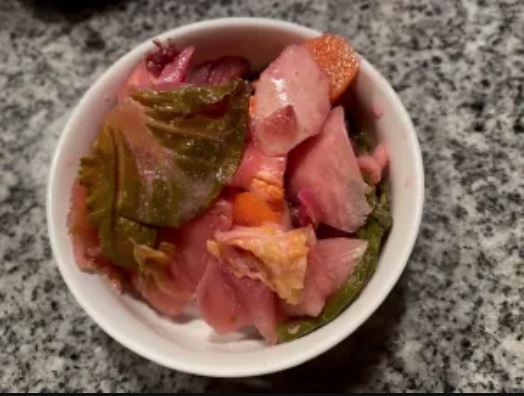
Magda Born
Most commercially available kimchi ferments are very spicy and contain MSG. I experimented with my own version, and the results differ by varying the amount of ginger and different vegetables based on what is fresh and available. In this recipe, I use a mild version of fish sauce. Fish sauce adds a surprisingly delicious and complex flavor.
Ingredients
- 8 Tbsp Sweet rice flour
- 16 Tbsp Cold water
- 5 Tbsp Cane sugar
- 1 Chinese cabbage (green or purple)
- 2 Large onions (or several small shallots)
- 2 Carrots (thinly sliced)
- 1 Large Japanese daikon radish
- 4 inch Root ginger
- 8 cloves Garlic
- 2 Tbsp Salt (plus extra for wilting)
- 1 bunch Spring onions
- Fish sauce to taste (3-5 T)
- Hot pepper powder (optional)
- Horseradish root or turmeric root (optional)
Instructions
As with all the recipes, high-quality ingredients result in a better dish. I started with the freshest ingredients from the farmers’ market. After years of avoiding fish sauce, I found a brand I like, and it makes all the difference in the flavor of this ferment. The ingredients can be substituted by availability, so the end flavor will be different each time. It is a good thing to be surprised in this case.
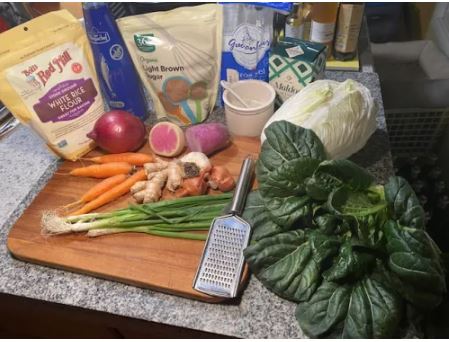
Either green or red Chinese cabbage can be used.
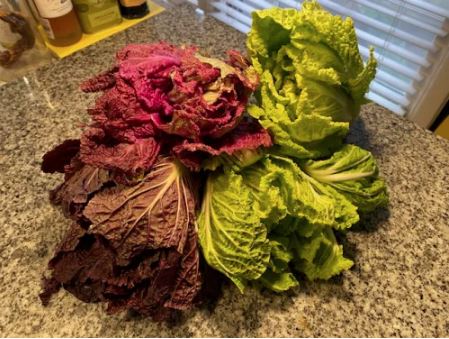
Start with making the porridge. Mix rice flour with cold water, and cook for about 3 minutes while mixing well. Add sugar and let cool.
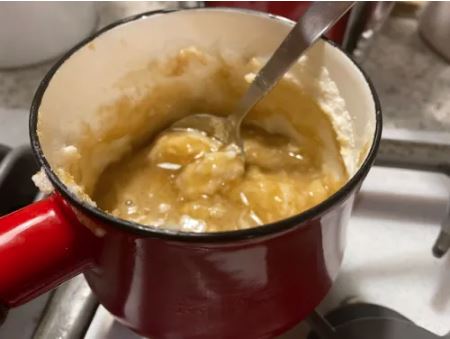
Chop, Salt, Pack, and Wait
Wash the cabbage and remove the outer leaves. Set outer leaves aside. Cut Chinese cabbage into quarters, remove the inner core, and cut into 1-2 inch pieces.
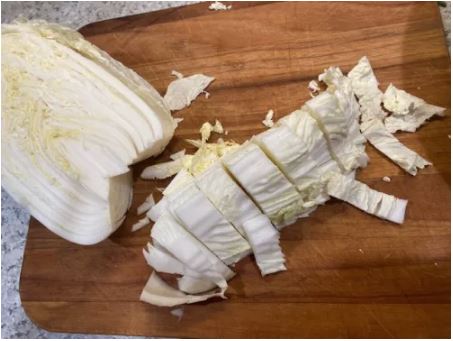
In a large bowl, add the cabbage and salt and mix well while gently massaging the cabbage and salt with your hands to tenderize it. Bruising the vegetables breaks down the cell walls and facilitates the release of juices. Mix well and let wilt for two hours. After 2-4 hours (depending on the amount of cabbage), the volume of cabbage will shrink and will start releasing its juices, creating natural brine.
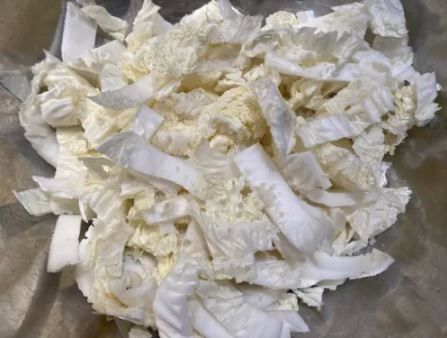
Chop all vegetables into even pieces. Shredded vegetables will ferment faster, but vegetables in chunks will take longer.
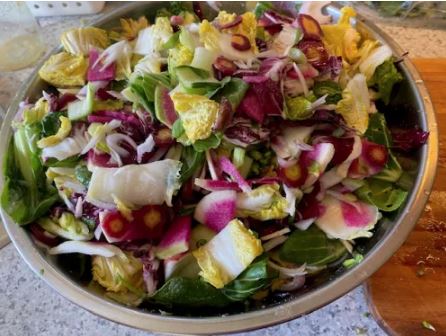
Using a fine grater, grate the ginger into a paste.
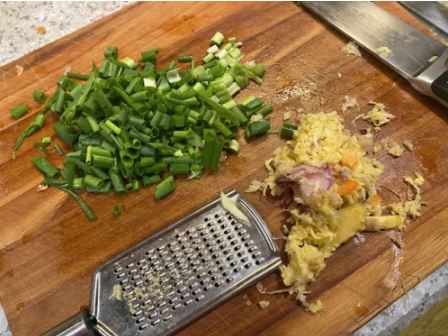
After two hours, rinse the wilted Chinese cabbage well and return to a clean bowl.
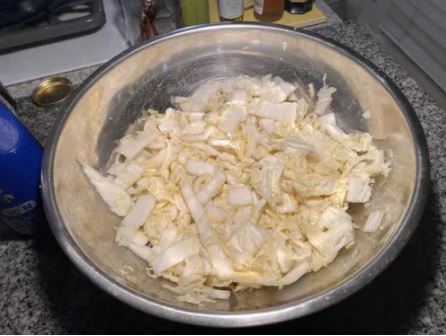
Stir all vegetables with rice porridge and Chinese cabbage and mix well using your hands.
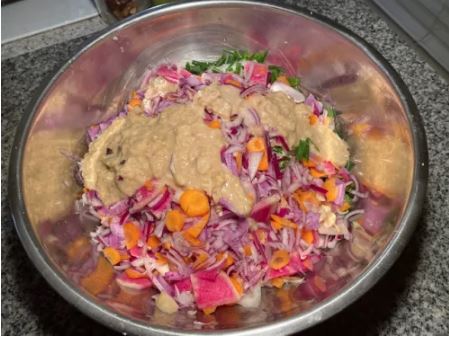
Tightly pack the vegetable mix into a fermentation container. To keep the vegetables down, cover them with a small plate and a weight (I use a rock) and keep pressing. More juice will come out above the vegetable levels, keeping them submerged. Cover with a kitchen towel and place in a dark but warm location on the kitchen counter. All vegetables are pre-inoculated with native lactic acid bacteria, initiating fermentation and undergoing lactic fermentation. In two or three days, the vegetables start to transform. Eventually, juice will start to emerge from the vegetables, and you will see bubbles forming. The brine should cover the vegetable ¼ to one inch. The ferment will get cloudy in the process, which is normal. White sediment forming on the bottom of the jar is also a normal part of the fermentation process.
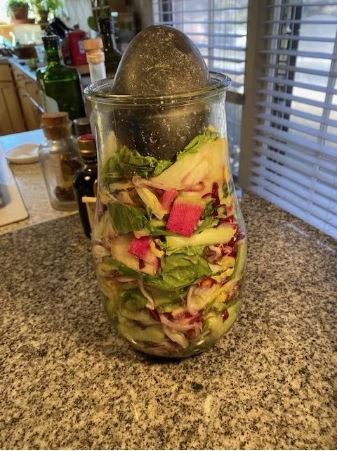
- If your kimchi looks like “nothing is happening,” Stir the vegetables and move them to a warmer location. This will encourage oxidation and stimulate yeast growth by exposing the ferment to air.
You can cover the top of the ferment with discarded outer leaves of the cabbage and use it as protection from oxidation and surface mold. If you see mold, scrape it off and discard the leaves at the end of the fermentation process.
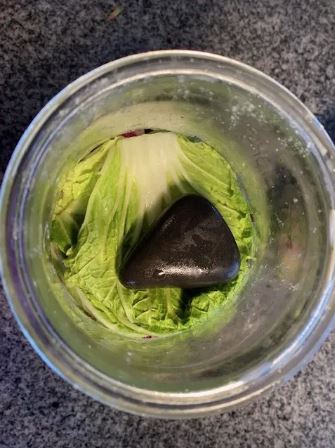
After three days on the kitchen counter, move the jar to an unheated basement or garage for another two weeks. At this point, cover the jar with a tight lid. Keeping the vegetables submerged is the most critical factor for success in vegetable fermentation. Add water if necessary. The temperature of the ferment is also important, between 60-75F being ideal. Taste your ferment often at this point. With time, acidification increases, and the flavor and texture will change. If the vegetables are not fully fermented, their flavor will be inferior, and they will have a poorer shelf life. If you are happy with the flavor that is developing, move them to the refrigerator. Refrigeration is a fermentation-slowing technique, and they will keep there the whole winter. Since fermentation shrinks the original volume, if you have more than one jar, they can be combined into one container.
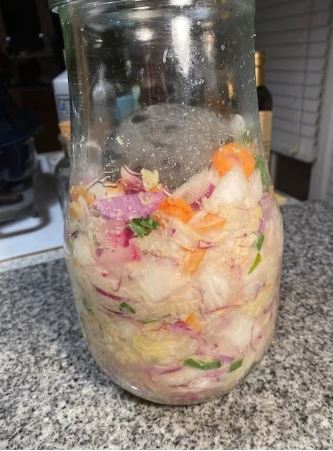
This is my most recent ferment and the tastiest so far. Each batch turns out a little different; you can experiment and tweak the recipe. Here I added more fish sauce and red Japanese radish instead of white daikon.
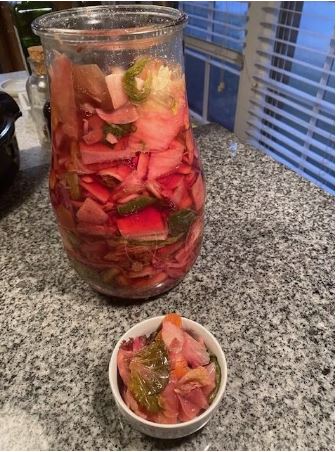
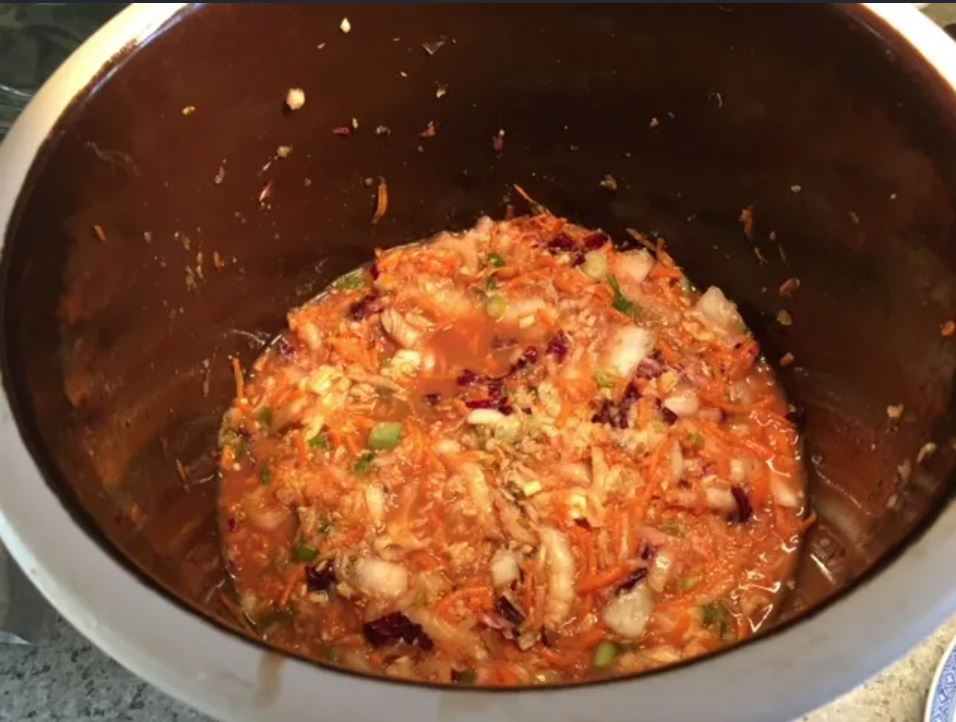
East something wild every day!
Magda Born
Community Services Librarian
Kansas City, Kansas Public Library
625 Minnesota Ave.
Kansas City, KS 66101
913-295-8250 ext 1103
Sources:
https://www.ncbi.nlm.nih.gov/pmc/articles/PMC6723656/
https://www.health.harvard.edu/staying-healthy/fermented-foods-can-add-depth-to-your-diet
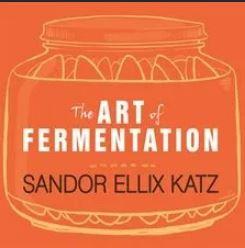
The art of fermentation: an in-depth exploration of essential concepts and processes from around the world by Sandor Ellix Katz
'The Art of Fermentation' is the most comprehensive guide to do-it-yourself home fermentation ever published. Sandor Katz presents the concepts and processes behind fermentation in ways that are simple enough to guide a reader through their first experience making sauerkraut or yogurt, and in-depth enough to provide greater understanding and insight for experienced practitioners.
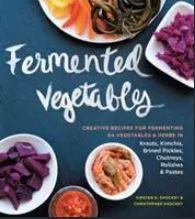
Fermented vegetables: creative recipes for fermenting 64 vegetables & herbs in krauts, kimchis, brined pickles, chutneys, relishes & pastes by Kirsten Shockey and Christopher Shockey
A classic preserving method, the fermentation process yields nutrient-dense live foods packed with vitamins, minerals, enzymes, and probiotic goodness. The Shockeys show you the techniques, and then help you explore how to apply these simple skills to fresh vegetables, herbs, and even a few fruits.
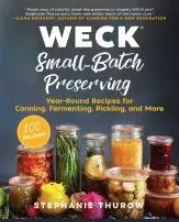
Weck small-batch preserving: year-round recipes for canning, fermenting, pickling, and more by Stephanie Thurow
Collects small-batch recipes for canning, fermenting, and infusing in glass jars, including such options as apple butter, pickled green tomatoes, raspberry jam, and spicy pear chutney, along with a step-by-step guide on how to preserve foods.
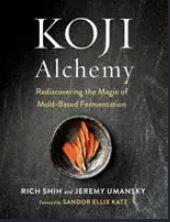
Koji alchemy: rediscovering the magic of mold-based fermentation by Rich Shih, Jeremy Umansky and Sandor Ellix Katz
Koji Alchemy guides readers through the history and diverse application of koji, the microbe behind the delicious, umami flavors of soy sauce, miso, mirin, and so much more. Devoted authors Jeremy Umansky and Rich Shih share processes, concepts, and recipes for fermenting and culturing foods with this magical ingredient. Then they take it to the next level by describing how they rapidly age charcuterie, cheese, and other ferments, revolutionizing the creation of fermented foods and their flavor profiles for both chefs and home cooks. Readers will learn how to grow koji, including information on equipment and setting up your kitchen, as well as detailed concepts and processes for making amino sauces and pastes, alcohol and vinegar, and using it for flavor enhancement with dairy, eggs, vegetables, and baking. With the added tips and expertise from their friends, Umansky and Shih have developed a comprehensive look at modern koji use around the world